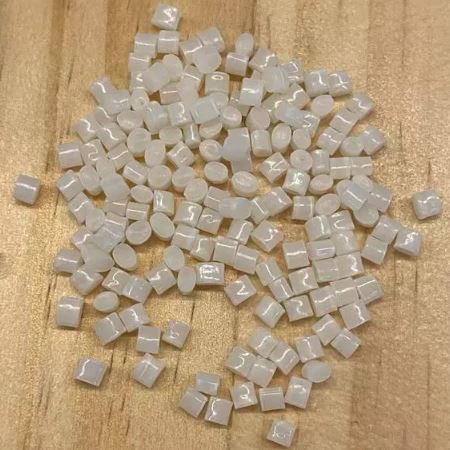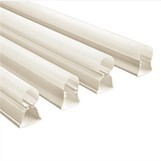As a seasoned supplier of Modified ABS, I've witnessed firsthand the remarkable versatility and potential of this engineered plastic. Modified ABS, a blend of acrylonitrile, butadiene, and styrene polymers, offers enhanced properties compared to standard ABS, making it suitable for a wide range of applications across various industries. In this blog post, I'll explore the post - processing options available for Modified ABS, shedding light on how these processes can further enhance its performance and aesthetics.
Machining
Machining is a common post - processing method for Modified ABS. It allows for the creation of precise shapes and dimensions that may not be achievable through molding alone. The relatively good machinability of Modified ABS makes it a preferred choice for parts that require tight tolerances.
When machining Modified ABS, several factors need to be considered. The cutting speed should be carefully adjusted to prevent overheating, which can lead to melting or deformation of the material. High - speed steel or carbide tools are commonly used due to their durability and ability to maintain sharp edges. Drilling, milling, and turning are some of the typical machining operations performed on Modified ABS. For example, in the production of custom - made automotive interior parts, machining can be used to create detailed contours and holes for switches and knobs.
Welding
Welding is another important post - processing option for Modified ABS. It enables the joining of different parts made from Modified ABS, creating larger and more complex structures. There are several welding techniques available, each with its own advantages and limitations.
Hot - plate welding is a popular method for joining Modified ABS parts. In this process, the surfaces to be joined are heated by a hot plate until they reach a molten state. Then, the two parts are pressed together, and the molten plastic fuses, forming a strong bond. Ultrasonic welding is also widely used. It uses high - frequency ultrasonic vibrations to generate heat at the joint interface, melting the plastic and creating a weld. This method is fast and suitable for small - to medium - sized parts. For instance, in the manufacturing of electronic enclosures, welding can be used to assemble different sections of the enclosure, providing a seamless and sturdy structure.


Surface Finishing
Surface finishing plays a crucial role in enhancing the appearance and functionality of Modified ABS parts. There are various surface finishing techniques available, each offering different effects.
Painting is a common surface finishing option. It can improve the aesthetic appeal of Modified ABS parts by providing a smooth and uniform color. Additionally, paint can offer protection against UV radiation, chemicals, and abrasion. Before painting, the surface of the Modified ABS needs to be properly prepared to ensure good adhesion. This may involve cleaning, sanding, and applying a primer.
Plating is another surface finishing technique that can be applied to Modified ABS. Electroplating Grade ABS is specifically designed to be suitable for electroplating processes. Electroplating can provide a metallic finish to the Modified ABS parts, enhancing their appearance and providing additional properties such as conductivity and corrosion resistance. For example, in the production of decorative automotive trim, electroplating can give the parts a shiny and luxurious look.
Assembly
Assembly is an essential post - processing step for many Modified ABS products. It involves putting together different components to create a complete product. Depending on the design requirements, various assembly methods can be used.
Mechanical fasteners such as screws, nuts, and bolts are commonly used for assembling Modified ABS parts. They provide a reliable and easy - to - disassemble connection. Adhesive bonding is another option. Adhesives can be used to join parts together, providing a strong and seamless bond. When using adhesives, it's important to choose the right type of adhesive that is compatible with Modified ABS. For example, in the assembly of consumer electronics, both mechanical fasteners and adhesives may be used in combination to ensure a secure and stable structure.
Heat Treatment
Heat treatment can be used to improve the dimensional stability and mechanical properties of Modified ABS. Annealing is a common heat - treatment process. In this process, the Modified ABS parts are heated to a specific temperature below their melting point and held at that temperature for a certain period of time. Then, they are slowly cooled. Annealing can relieve internal stresses that may have been introduced during molding or machining, reducing the risk of warping and cracking.
For Heat Resistance Grade ABS, heat treatment can further enhance its heat - resistant properties. By carefully controlling the heat - treatment parameters, the material's glass transition temperature can be increased, allowing it to maintain its shape and performance at higher temperatures. This is particularly important for applications in the automotive and electrical industries, where parts may be exposed to high - temperature environments.
Impact of Post - Processing on Different Grades of Modified ABS
Different grades of Modified ABS, such as General Grade ABS, Heat Resistance Grade ABS, and Electroplating Grade ABS, may respond differently to post - processing.
General Grade ABS is a versatile material that can be easily machined, welded, and surface - finished. It is suitable for a wide range of applications where moderate performance is required. However, its heat - resistance and electroplating properties may be limited compared to the specialized grades.
Heat Resistance Grade ABS is designed to withstand high temperatures. Post - processing operations such as heat treatment can further optimize its heat - resistant performance. When machining or welding this grade, special care needs to be taken to ensure that the high - temperature properties are not compromised.
Electroplating Grade ABS is specifically engineered for electroplating processes. It has a unique surface structure and composition that allows for good adhesion of the plating layer. Other post - processing operations such as machining and welding should be carried out in a way that does not damage the surface properties required for electroplating.
Conclusion
In conclusion, the post - processing options for Modified ABS are diverse and offer numerous opportunities to enhance the performance, appearance, and functionality of the final products. Whether it's machining for precision, welding for joining, surface finishing for aesthetics and protection, assembly for creating complete products, or heat treatment for improving properties, each post - processing method has its own role to play.
As a Modified ABS supplier, I understand the importance of providing high - quality materials that are suitable for these post - processing operations. We are committed to working closely with our customers to ensure that they have the right Modified ABS grade for their specific applications and that they can achieve the best results through proper post - processing.
If you are interested in purchasing Modified ABS for your projects or have any questions about post - processing options, please feel free to reach out to us for a detailed discussion. We look forward to partnering with you to bring your innovative ideas to life.
References
- "Plastics Engineering Handbook" by George E. Totten
- "Handbook of Polymer Science and Technology" edited by Herman F. Mark




